Volos
Volos Βόλος | ||
|---|---|---|
 Volos seaside by night | ||
| ||
 Volos Location within the region  | ||
| Coordinates: 39°22′N 22°56′E / 39.367°N 22.933°E / 39.367; 22.933Coordinates: 39°22′N 22°56′E / 39.367°N 22.933°E / 39.367; 22.933 | ||
| Country | Greece | |
| Administrative region | Thessaly | |
| Regional unit | Magnesia | |
| Districts | 18 | |
| Government | ||
| • Mayor | Achilleas Beos (since 2014) | |
| Area | ||
| • Municipality | 385.6 km2 (148.9 sq mi) | |
| • Municipal unit | 27.678 km2 (10.687 sq mi) | |
| Highest elevation | 5 m (16 ft) | |
| Lowest elevation | 0 m (0 ft) | |
| Population (2011)[1] | ||
| • Municipality | 144,449 | |
| • Municipality density | 370/km2 (970/sq mi) | |
| • Municipal unit | 125,248 | |
| • Municipal unit density | 4,500/km2 (12,000/sq mi) | |
| Time zone | UTC+2 (EET) | |
| • Summer (DST) | UTC+3 (EEST) | |
| Postal code | 38x xx | |
| Area code(s) | 24210 | |
| Vehicle registration | ΒΟx | |
| Website | www.volos-city.gr | |
Volos (Greek: Βόλος) is a coastal port city in Thessaly situated midway on the Greek mainland, about 330 kilometres (205 miles) north of Athens and 220 kilometres (137 miles) south of Thessaloniki. It is the capital of the Magnesia regional unit. Volos is the only outlet to the sea from Thessaly, the country's largest agricultural region. With a population of 144,449 (2011), it is an important industrial centre, while its port provides a bridge between Europe, the Middle East and Asia.
Volos is the newest of the Greek port cities, with a large proportion of modern buildings erected following the catastrophic earthquakes of 1955. It includes the municipal units of Volos, Nea Ionia and Iolkos, as well as smaller suburban communities. The economy of the city is based on manufacturing, trade, services and tourism. Home to the University of Thessaly, the city also offers facilities for conferences, exhibitions and major sporting, cultural and scientific events. Volos participated in the 2004 Olympic Games, and the city has since played host to other athletic events, such as the European Athletic Championships. Volos hosted the 7th International Olympiad on Astronomy and Astrophysics from 27 July to 5 August 2013.[2]
Contents
1 Location
2 History
2.1 Antiquity
2.2 Byzantine era
2.3 Ottoman era
2.4 Modern Volos
3 Administration
3.1 Province
4 Geography
4.1 Climate
5 Architecture
6 Districts
7 Education
8 Economy
9 Port
10 International relations
10.1 International consulates
10.2 Twin towns — sister cities
11 Culture
11.1 Museums and galleries
11.2 Cuisine
11.3 Sports
12 Transport
12.1 Motorways
12.2 Airport
12.3 Railway
13 Notable people
13.1 Mythology
13.2 Modern
13.3 Athletes
14 See also
15 Footnotes
16 References
17 External links
Location
Built at the innermost point of the Pagasetic Gulf and at the foot of Mount Pilio (Pelion, the land of the Centaurs). The city spreads in the plain on the foothills of Mount Pelion, bordering the town of Agria to the east and Nea Anchialos to the south west. Volos' municipality includes both towns, along with many nearby villages, including Makrinitsa and Portaria.
Volos is a major commercial port of mainland Greece in the Aegean sea (after Piraeus and Thessaloniki), with connection by ferry and hydrofoil to the nearby Sporades Islands, which include Skiathos, Skopelos and Alonissos. There are also connections to Limnos, Lesvos, Chios and Skyros.
History
Antiquity

The return of the Argonauts by Constantine Volanakis (1837–1907).
Modern Volos is built on the area of the ancient cities of Demetrias, Pagasae and Iolcos. Demetrias was established by Demetrius Poliorcetes, King of Macedon. Iolkos or Iolcus, was the homeland of mythological hero Jason, who boarded the ship Argo accompanied by the Argonauts and sailed in quest of the Golden Fleece to Colchis. To the west of Volos lie the Neolithic settlements of Dimini, with a ruined acropolis, walls, and two beehive tombs dating to between 4000–1200 BC, Sesklo, with the remains of the oldest acropolis in Greece (6000 BC), and also the foundations of a palace and mansions[clarification needed], among its most characteristic examples of Neolithic civilisation.
Byzantine era
During the course of the 8th century, mainland Greece was subjected to numerous Bulgarian raids. At the end of the century, a large scale Bulgarian military expedition headed by the chieftain Akamir was launched from Belasica. The Bulgarians plundered Thessalia, from their encampment which was located between modern day Volos and Velestino. The Byzantines called those Bulgarians Velegizitas or Vielesti. Volos, Velestino, Zagora and many other placenames in Magnesia originate from that period and are of Slavic origin. The first reference to Golos (Greek: "Γόλος") comes from a Byzantine document dated to 1333, while Volos appears to be a later corruption of the term. Golos probably originated from the Slavic word gološ 'seat of administration',[3] or perhaps from gol "bald, naked", as the area has sparse vegetation. Two alternative theories allude to a Greek origin through the words βολή (throw), as fishermen threw their nets into the sea from that area, and βώλος (piece of land). In the 14 century Volos came under the control of Serbia, subsequent conquest by the Republic of Venice and the Catalans led to a large drop in the local population.[4]
Ottoman era

The port of Volos by Constantine Volanakis (c.1875).
Volos was held by the Ottoman Empire from 1393–1397 and the in 1403, and finally conquered in 1423.[3] The Ottoman name of the city was قلز "Quluz";[3] it marked the southern border of the Vilayet-i Rumeli-i Şarki. Later, it was a center of a kaza in the Sanjak of Tirhala, which was part of Jannina Vilayet.
At the beginning of the Greek Revolution, the provisional government of Greece claimed Volos as part of Greek national territory, but the Treaty of Constantinople (1832), which established a Greek independent state, set its northern boundary between Arta and Volos.[5] However, Volos was incorporated into the Greek Kingdom in 1881 with the rest of Thessaly.
Modern Volos
Volos is a relatively new city, beginning its strongest growth in the mid-19th century.[citation needed] The locality of its castle was previously known as Golos by Ottomans and locals, while Ano Volos was known as Gkolos.[citation needed].
After its incorporation into the Greek Kingdom from the Ottoman Empire in 1881, the town had a population of only 4,900, but grew rapidly in the next four decades as merchants, businessmen, craftsmen and sailors gravitated toward it from the surrounding area. In the 1920s a large influx of refugees to the settlement took place, especially from Ionia, but also from Pontus, Cappadocia and Eastern Thrace. In 1882, Andreas Syngros established the Privileged Bank of Epirus and Thessaly, which the National Bank of Greece acquired in 1899 after its founder's death. Volos was occupied by Ottomans on 8 May 1897, during the Greco Turkish War.[6]
The city had a vibrant Jewish community in the early 20th century: from ca. 500 in 1896, it rose to ca. 2,000 in 1930, before falling drastically to 882 members in 1940, because of emigration to the great cities of Thessaloniki and Athens or abroad. During the Axis occupation of Greece, the prompt actions of the local chief rabbi, Moshe Pessach, and the Greek authorities, saved about 700 of the local Jewish community from deportation to the Nazi death camps.[7]

Modern sculpture of Argo, the mythic ship of the Argonauts, at the port
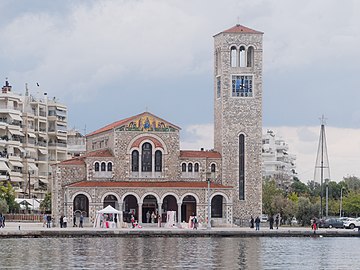
The church of Saints Constantine and Helen at the seafront
The municipal music hall
Modern monument
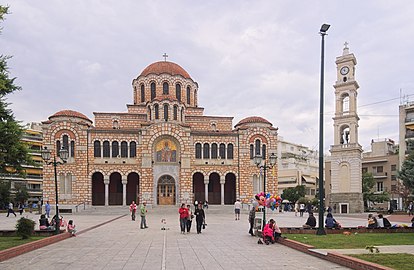
St Nicholas
Volos is also well known for its assortment of mezedes and a clear, alcoholic beverage known as tsipouro.
A street in a sister city, Rostov-on-Don, bears the name Улица Греческого Города Волос (Street of the Greek City of Volos), weaving through a mix of early 20th century buildings with characteristic inner yards, tiered balconies and open iron stairs that lend the old Rostov its characteristic Mediterranean look.
Administration
The municipality Volos was formed at the 2011 local government reform by the merger of the following 9 former municipalities, that became municipal units:[8]
- Agria
- Aisonia
- Artemida
- Iolcos
- Makrinitsa
- Nea Anchialos
- Nea Ionia
- Portaria
- Volos
The municipality has an area of 385.614 km2, the municipal unit 27.678 km2.[9]
Province
The province of Volos (Greek: Επαρχία Βόλου) was one of the provinces of the Magnesia Prefecture. Its territory corresponded with that of the current municipalities Volos, Rigas Feraios, South Pelion and Zagora-Mouresi.[10] It was abolished in 2006.
Geography

Volos panorama from Pelion mountain.

Climate graph of Volos.
Volos is the administrative centre of the Magnesia regional unit. Many of the city domains are separated through natural barricades, such as rivers.
Three main rivers/mountain torrents all rise from mount Pelion (with its peak at 1,610 metres (5,280 feet)), crossing the city to create a unique urban geography, before ending in the Pagasetic Gulf flowing west. The Anavros river, famous for Jason's pass, divides the Nea Demetriada district from the rest of the urban area. Krafsidonas is the major river passing through the city, and constitutes the natural lung of the urbanized area of Volos, as well as the boundary between the major municipalities of the metropolitan city, the municipalities of Volos and Nea Ionia. Xirias (Ξηριάς), is the largest torrent of the metropolitan urban area of Volos, and passes through the Nea Ionia municipal area.
Climate
Volos, having a Csa Mediterranean climate, typically experiences neither particularly high nor extremely low temperatures throughout the year. Its climate is one of a low humidity, favourable for all kinds of activities. The Pelion mountain, with its own microclimate, affects the city's weather.[citation needed]
| Climate data for Volos (1958–1983) | |||||||||||||
|---|---|---|---|---|---|---|---|---|---|---|---|---|---|
| Month | Jan | Feb | Mar | Apr | May | Jun | Jul | Aug | Sep | Oct | Nov | Dec | Year |
| Record high °C (°F) | 23.0 (73.4) | 24.7 (76.5) | 26.0 (78.8) | 34.0 (93.2) | 35.2 (95.4) | 45.3 (113.5) | 44.2 (111.6) | 39.6 (103.3) | 36.8 (98.2) | 30.4 (86.7) | 27.2 (81.0) | 24.4 (75.9) | 45.3 (113.5) |
| Average high °C (°F) | 11.3 (52.3) | 12.9 (55.2) | 15.0 (59.0) | 19.4 (66.9) | 24.0 (75.2) | 28.5 (83.3) | 31.0 (87.8) | 30.6 (87.1) | 27.0 (80.6) | 21.7 (71.1) | 17.3 (63.1) | 13.2 (55.8) | 21.0 (69.8) |
| Daily mean °C (°F) | 7.8 (46.0) | 9.0 (48.2) | 11.3 (52.3) | 15.4 (59.7) | 20.1 (68.2) | 24.6 (76.3) | 27.0 (80.6) | 26.6 (79.9) | 22.9 (73.2) | 17.7 (63.9) | 13.3 (55.9) | 9.6 (49.3) | 17.4 (63.3) |
| Average low °C (°F) | 4.5 (40.1) | 5.4 (41.7) | 7.3 (45.1) | 10.5 (50.9) | 14.9 (58.8) | 19.0 (66.2) | 21.3 (70.3) | 21.2 (70.2) | 17.9 (64.2) | 13.6 (56.5) | 9.8 (49.6) | 6.3 (43.3) | 12.6 (54.7) |
| Record low °C (°F) | −8.2 (17.2) | −7.8 (18.0) | −3.2 (26.2) | 1.8 (35.2) | 6.2 (43.2) | 11.6 (52.9) | 14.0 (57.2) | 14.8 (58.6) | 9.2 (48.6) | 1.4 (34.5) | 0.6 (33.1) | −6.0 (21.2) | −8.2 (17.2) |
| Average precipitation mm (inches) | 58.4 (2.30) | 35.4 (1.39) | 40.5 (1.59) | 27.3 (1.07) | 32.5 (1.28) | 22.5 (0.89) | 15.1 (0.59) | 10.9 (0.43) | 35.0 (1.38) | 51.8 (2.04) | 52.2 (2.06) | 47.2 (1.86) | 428.8 (16.88) |
| Average precipitation days (≥ 1.0 mm) | 10.5 | 9.7 | 9.9 | 8.2 | 6.6 | 5.2 | 2.8 | 2.7 | 5.3 | 8.1 | 10.1 | 10.1 | 89.2 |
| Average relative humidity (%) | 72.7 | 70.0 | 69.5 | 65.7 | 65.0 | 61.2 | 58.1 | 60.1 | 65.5 | 70.4 | 74.0 | 73.7 | 67.2 |
| Mean monthly sunshine hours | 104.7 | 117.8 | 157.5 | 213.8 | 266.3 | 307.2 | 337.1 | 320.1 | 247.6 | 171.8 | 126.0 | 101.0 | 2,470.9 |
| Source: Meteovolos[11] | |||||||||||||
Architecture
Volos used to have plenty of old mansions, the majority of which was destroyed after the earthquakes in 1955. Nowadays, only some of them have been saved, restored and have a new, mainly public, use.
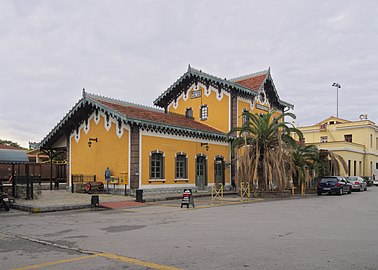
The old railway station, designed by Evaristo De Chirico.
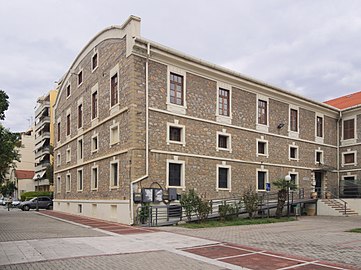
The old Spierer tobacco warehouse

Archaeological Museum of Volos
The development of the new city coincided with the flourishing of neoclassicism. Public buildings conformed to this style and prestigious private buildings belonging to prosperous merchants were particularly sophisticated. Typical examples include:
- The 3-storeyed Hotel de France, with its impressive decorative murals (1894, Iasonos and K. Kartali Street)
- Old Tobacco Factory of Matsaggos (1890)
- Yellow Warehouse
- The National Bank, formerly the Epirothessalian Bank (1895)
- The Athens Bank (1903, today the library of University of Thessaly)
- The Achillopouleion Hospital (1901)
- The Archaeological Museum of Volos, Athanasakeio (1909)
- The Agricultural Bank (1909, formerly the Kosmadopoulos Bank)
- The Cinetheater Achillion (1925)
- The Aegli Hotel, (1927), designed by Kassiopoulos
- The Building of the Air-force High officials Club near Agios Konstantinos Park, believed to have been designed by Le Corbusier
- The Bank of Greece (1935)
- Municipal conservatory of Volos
- The old factory of Tsalapatas
- Tsikrikis Mansion
- Kitsos Makris' house(today Kitsos Makris Folklore Centre)
- Volos Mayor House
- The Railway Station of Volos, designed by Evaristo De Chirico
- The Averofeian courts of Justice
- The family houses of Kartalis, Glavanis, Kastemis, Saratsis
- The Sarafopoulos Mansion (1927), today the Volos Club
- The well preserved Regas house and its singular decorative murals, today the Lyceum of Greek women
Districts
City Centre (35,420)
| North (15,000)
| North-West (33,000)
|
Education

The administrative building of the University of Thessaly at the promenade
The city of Volos consists the administrative and academic centre of University of Thessaly, which was founded in 1984 and consists the most important centre of education in central Greece. The faculties of Engineering, Humanities and Social Sciences and Agricultural Sciences with twelve Departments are based in Volos, enforcing the academic, economic and cultural development of the city. The faculties are located in different places in the city. “Pedion Areos” Campus is used by the Departments of the School of Engineering, the School of Humanities and Social Sciences is located in the centre of the city, thus the School of Agricultural Sciences is based in a renovated building in Fytoko. In addition to Greek students, the city and the University attract many foreign students via Erasmus and other programmes.
Moreover, in the city there are 56 kindergartens, 51 primary schools, 18 junior high schools and 13 senior high schools.[citation needed]
Economy

The rooftile and brickworks museum of old Tsalapatas factory
Volos is one of the most industrialized provincial cities of Greece, because of its strategic location between the largest population centers of the country (Athens – Thessaloníki) and its port. Industry is intensely specialized in steel production and manufacturing. Three major steel producers (METKA, SIDENOR and Hellenic Steel Industry (Ελληνική Χαλυβουργία)) have production facilities in the industrial areas of Volos and nearby Almyros.
AGET – Heracles, a member of the Lafarge group, operates one of the largest cement facilities in the world (with capacity exceeding 7,000,000 tn[12]) with its own private port, next to the city. Volos is also active in the research sector, hosting the Institute of Bio-Economy and Agri-Technology (iBO), one of the five Institutes of the Center for Research and Technology – Hellas (CERTH).[13]
Port
The port that lies upon ancient Iolkos where one of the most legendary sea. Here, at the safe port of the Pagasitikos bay, Jason built his trireme, Argo, and along with his oarsmen set course for Colhis bringing back and getting married to priestess Medea.
The new port was founded in 1893 and was the most significant element for the industrial development of the area. Today, Volos has the 3rd largest cargo port in Greece (after Piraeus and Thessaloniki), carrying agricultural and industrial products. In the past there was connection with Tartus in Syria.
Ferries and flying dolphins operate daily connecting Volos to Magnesia islands, Sporades (Skiathos, Skopelos, Alonissos). Moreover, many cruise ships use the port of Volos as a destination. During the summers of 2015 and 2016, more than 100 cruises arrived in Volos, carrying more than 100.000 visitors.[14]
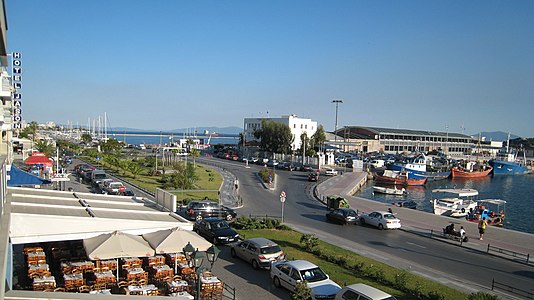
View of the port.
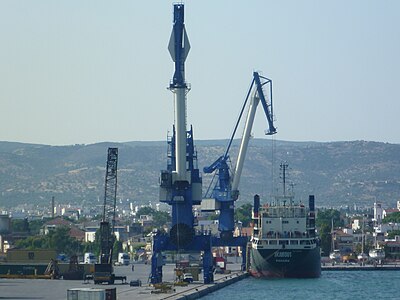
Cargo ship at the harbour.
The promenade
International relations
The city of Volos has always had a major role in the financial, economic, commercial and administrative matters of the region of Thessaly and Central Greece, due to the strategic position of the city's port, unique between Athens and Thessaloniki.
International consulates
Several European countries have established consulates in Volos including:
 Italy
Italy France
France Belgium
Belgium Germany
Germany Denmark
Denmark Netherlands
Netherlands
Twin towns — sister cities
Volos is twinned with:
 – Antofagasta, Chile
– Antofagasta, Chile – Batumi, Georgia[15]
– Batumi, Georgia[15] – Le Mans, France[16]
– Le Mans, France[16] – Pleven, Bulgaria
– Pleven, Bulgaria – Rostov-on-Don, Russia
– Rostov-on-Don, Russia – Smederevo, Serbia
– Smederevo, Serbia
Culture
The wider region of Volos is a place with great history, finding the first signals of culture in the Neolithic period. In the villages Sesklo and Dimini have been discovered the first findings of Neolithic culture in Europe.
Moreover, close to Volos there are the ancient Dimitrias, a town that was built by Dimitrios Poliorkitis in 294-2 AC. Today, the ancient theater of Dimitrias is saved. There are also the archaeological region of Goritsa hill, findings of Old-Christian period in Nea Anchialos and the wall of the old castle of Volos that someone can visit.
Volos consists of a city with various Greek trades, as the industrial development and the port conducted many people move in the city. The industrial and financial evolution of the city conducted in a cultural and social evolution too. In 1894, Volos acquired its Municipal Theater and in 1896 the Volos Gymnastic Club. In 1908, in Volos was founded the first Labor Union in Greece.
After 1922 with the Asia Minor Catastrophe, Volos received a large number of people coming from the destroyed regions. This coexistence with the locals influenced deeply the culture of the city, making this influence visible in the food, music, sports, entertainment and social life of the city.
Nowadays, there is a plenty of museums and galleries spread in the city, but also in the wide region. Moreover, Volos consists one of the most attractive and touristic cities in Greece because of its physical attributes combining the Pagasetic Gulf with the Mount Pelion.
Volos is a candidate city for the European Capital of Culture in 2021.[17]
Museums and galleries
Archaeological Museum of Volos[18]- Volos Natural History Museum
Modern History Museum of Volos City[19][20]
Thessaly Railway Museum, Railway Station of Volos- The Rooftile and Brickworks Museum N. & S. Tsalapatas, National Museum of Industrial History[21]
Cuisine
One of the main characteristics and touristic specialities of Volos is the traditional drink tsipouro and the sea food that is served accompanying the drink.
Local specialities include:
- Boubari
- Spetzofai
Melachrini (dessert)- Spoon sweets
Tsipouro (drink)
Sports
Volos, taking advantage of its physical attributes by the sea, has a significant presence in Greek sport history in racing rowing (sport) and sailing (sport). Furthermore, Volos has two closed and one open swimming pools, presenting a long history in swimming and water polo. Moreover, Volos has many clubs and facilities in several sport such as football, basketball, volleyball, tennis, horse-riding. The most popular clubs, with great offer in sport and cultural history of the city and significant successes in football, are Olympiakos Volou and Niki Volou. The main clubs of Volos are shown below.
| Sport clubs based in Volos | |||
|---|---|---|---|
| Club | Founded | Sports | Achievements |
| Niki Volou | 1924 | Football, Basketball and other sports | Presence in A Ethniki football |
| N.C. Volos-Argonauts | 1932 | Water Polo | Presence in A1 Ethniki women |
| Olympiakos Volou | 1937 | Football, Basketball and other sports | Europa League participant, Earlier presence in A Ethniki football, panhellenic title in women basketball |
| Ipotis equestrian club | 2002 | Horse riding | Presence in National competitions |
| Volos 2004 | 2004 | Football | Presence in A Ethniki women |
Volos uses to be one of the five cities that hosted the 2004 Summer Olympics.

Panthessaliko Stadium.
Volos after 2004, has hosted in its facilities significant sports events such as 27th European Championship of Artistic Gymnastics in 2006, the FIBA Europeaan Championship of Young Men (2015) when Greece acquired the gold medal and the Final of Greek Football Cup in 2007 and 2017.
Transport
All land transport reaches Volos, while the International Airport of Central Greece in Nea Anchialos links the city to international destinations, and the Port of Volos provides links to the islands, mostly the Sporades, as well as to some destinations in Pilio.
Motorways
Volos is linked through Greece's E75 Highway Axis (most often known as PATHE) with Northern and Southern Greece. Beyond this, the Axis E65 will be the gateway to Western Greece and the port of Igoumenitsa, through the plains of inner Thessaly; this part of the E65 motorway will be completed by 2012.
Airport
The city of Volos, along with the rest of Central Greece, is linked to the rest of Greece and Europe by the Nea Anchialos National Airport. The airport has the second longest commercial runway in Greece after Eleftherios Venizelos.
Volos is the first city in Europe to feature Seaplane Services[citation needed] through Argo Airways, which is based in Volos. The seaplanes connect Volos with Skiathos, Skopelos, Allonisos, Athens and Thessaloniki.
Railway
Today, the city is served by direct lines to the rest of Greece, and the railway complex houses facilities for train maintenance. Volos is directly linked with Athens once per day, with Thessaloniki twice per day, and with Larissa 15 times a day. In the past Volos was served by railway lines of three different gauges, the metre gauge line of Thessaly Railways to Kalampaka, the standard gauge line to Larissa and the 600 mm (1 ft 11 5⁄8 in) gauge line to Pelion. Remnants of triple gauge lines still exist near the station. Currently, the Pelion railway line operates for touristic reasons every Saturday, Sunday and public holiday from mid-April to the end of October. The train runs every day during July and August.
Notable people

Giorgio de Chirico (1888–1978) was born in Volos.

Vangelis Papathanasiou (Vangelis).

Dimitrios Trichopoulos
Mythology
Iason, mythological hero
Peleus, mythological hero
Chiron, centaur
Modern
Giorgio de Chirico, painter (1888–1978)
Vangelis, composer (1943)
Dimitrios Trichopoulos, medical doctor, Professor of Harvard School of Public Health
Georgios Kartalis, politician (1908–1957)
John Argyris, engineer (1913–2004)
Yorgos Foudoulis, musician and composer (1964)
Phaidon Gizikis, army officer and President of Greece during the junta (1917–1999)
Moshe Pesach, rabbi of Volos and Chief Rabbi of Greece
Lavrentis Mahairitsas, musician and songwriter (1956)
Athletes
Vasileios Polymeros, rower, olympic medalist (1976)
Nikolaos Skiathitis, rower, olympic medalist (1981)
Olga Vasdeki, triple jumper (1973)
Spyridon Vasdekis, long jumper (1970)
Paraskevi Tsiamita, triple, long jumper (1972)
Nikos Boudouris, basketball player (1971)
Panagiotis Liadelis, basketball player (1974)
Athanasios Kostoulas, football player (1976)
Christos Volikakis, track cyclist (1988)
Adam Tzanetopoulos, football player (1995)
See also
- Thessaly
- Magnesia
- Pelion
- Sporades
- University of Thessaly
- Giorgio de Chirico
- George Doundoulakis
Footnotes
^ ab "Απογραφή Πληθυσμού - Κατοικιών 2011. ΜΟΝΙΜΟΣ Πληθυσμός" (in Greek). Hellenic Statistical Authority..mw-parser-output cite.citationfont-style:inherit.mw-parser-output .citation qquotes:"""""""'""'".mw-parser-output .citation .cs1-lock-free abackground:url("//upload.wikimedia.org/wikipedia/commons/thumb/6/65/Lock-green.svg/9px-Lock-green.svg.png")no-repeat;background-position:right .1em center.mw-parser-output .citation .cs1-lock-limited a,.mw-parser-output .citation .cs1-lock-registration abackground:url("//upload.wikimedia.org/wikipedia/commons/thumb/d/d6/Lock-gray-alt-2.svg/9px-Lock-gray-alt-2.svg.png")no-repeat;background-position:right .1em center.mw-parser-output .citation .cs1-lock-subscription abackground:url("//upload.wikimedia.org/wikipedia/commons/thumb/a/aa/Lock-red-alt-2.svg/9px-Lock-red-alt-2.svg.png")no-repeat;background-position:right .1em center.mw-parser-output .cs1-subscription,.mw-parser-output .cs1-registrationcolor:#555.mw-parser-output .cs1-subscription span,.mw-parser-output .cs1-registration spanborder-bottom:1px dotted;cursor:help.mw-parser-output .cs1-ws-icon abackground:url("//upload.wikimedia.org/wikipedia/commons/thumb/4/4c/Wikisource-logo.svg/12px-Wikisource-logo.svg.png")no-repeat;background-position:right .1em center.mw-parser-output code.cs1-codecolor:inherit;background:inherit;border:inherit;padding:inherit.mw-parser-output .cs1-hidden-errordisplay:none;font-size:100%.mw-parser-output .cs1-visible-errorfont-size:100%.mw-parser-output .cs1-maintdisplay:none;color:#33aa33;margin-left:0.3em.mw-parser-output .cs1-subscription,.mw-parser-output .cs1-registration,.mw-parser-output .cs1-formatfont-size:95%.mw-parser-output .cs1-kern-left,.mw-parser-output .cs1-kern-wl-leftpadding-left:0.2em.mw-parser-output .cs1-kern-right,.mw-parser-output .cs1-kern-wl-rightpadding-right:0.2em
^ http://www.ioaa2013.gr/ 7th International Olympiad on Astronomy and Astrophysics official website
^ abc Encyclopedia of Islam, 2nd edition, s.v. Ḳuluz
^ Kordatos 1977, pp. 27–29.
^ Comstock, John (1829). History of the Greek Revolution. New York: W. W. Reed & co. p. 5.
^ Cathy Gere (2010). Knossos and the Prophets of Modernism. University of Chicago Press. p. 99. ISBN 978-0-226-28955-7.
^ Shmuel Spector; Geoffrey Wigoder, eds. (2001). Volos. The Encyclopedia of Jewish Life Before and During the Holocaust, Volume 3: Seredina-Buda–Z. New York: New York University Press. pp. 1411–1412. ISBN 9780814793787.
^ Kallikratis law Greece Ministry of Interior (in Greek)
^ "Population & housing census 2001 (incl. area and average elevation)" (PDF) (in Greek). National Statistical Service of Greece.
^ "Detailed census results 1991" (PDF). (39 MB) (in Greek) (in French)
^ "Volos Climate Normals 1958–1983". Hellenic National Meteorology Service. Retrieved June 18, 2014.
^ "AGET Hraklis Facilities". Archived from the original on 2008-02-08. Retrieved 2007-11-08.
^ [1]
^ [2]
^ "Batumi – Twin Towns & Sister Cities". Batumi City Hall. Archived from the original on 2012-05-04. Retrieved 2013-08-10.
^ "Twinnings" (PDF). Central Union of Municipalities & Communities of Greece. Retrieved 2013-08-25.
^ Volos 2021
^ vagelis tsekeris. "Archaeological Museum of Volos". Travelinfo.gr. Archived from the original on 2010-06-29. Retrieved 2009-07-27.
^ "Archived copy". Archived from the original on 2007-07-01. Retrieved 2007-06-13.CS1 maint: Archived copy as title (link) Modern History Museum of Volos City
^ "ΜΟΥΣΕΙΟ ΠΟΛΗΣ – Σχεδιασμός". www.i-politismos.gr. Archived from the original on 2009-01-30. Retrieved 2009-07-27.
^ "::: Piraeus Bank Group Cultural Foundation :::". Piop.gr. Retrieved 2009-07-27.
References
.mw-parser-output .refbeginfont-size:90%;margin-bottom:0.5em.mw-parser-output .refbegin-hanging-indents>ullist-style-type:none;margin-left:0.mw-parser-output .refbegin-hanging-indents>ul>li,.mw-parser-output .refbegin-hanging-indents>dl>ddmargin-left:0;padding-left:3.2em;text-indent:-3.2em;list-style:none.mw-parser-output .refbegin-100font-size:100%
Kordatos, Ioannis (1977). Η Επανάσταση στην Θεσσαλομαγνησία το 1821 [The Revolt in Thessalomagnesia in 1821] (in Greek). Athens: Epikairotita.
External links
 Volos travel guide from Wikivoyage
Volos travel guide from Wikivoyage
Volos The Official website of the Greek National Tourism Organisation- Homepage of the Municipality of Nea Ionia
| Wikimedia Commons has media related to Volos. |














